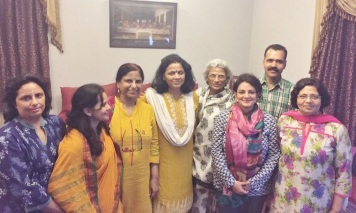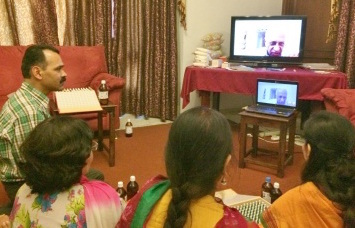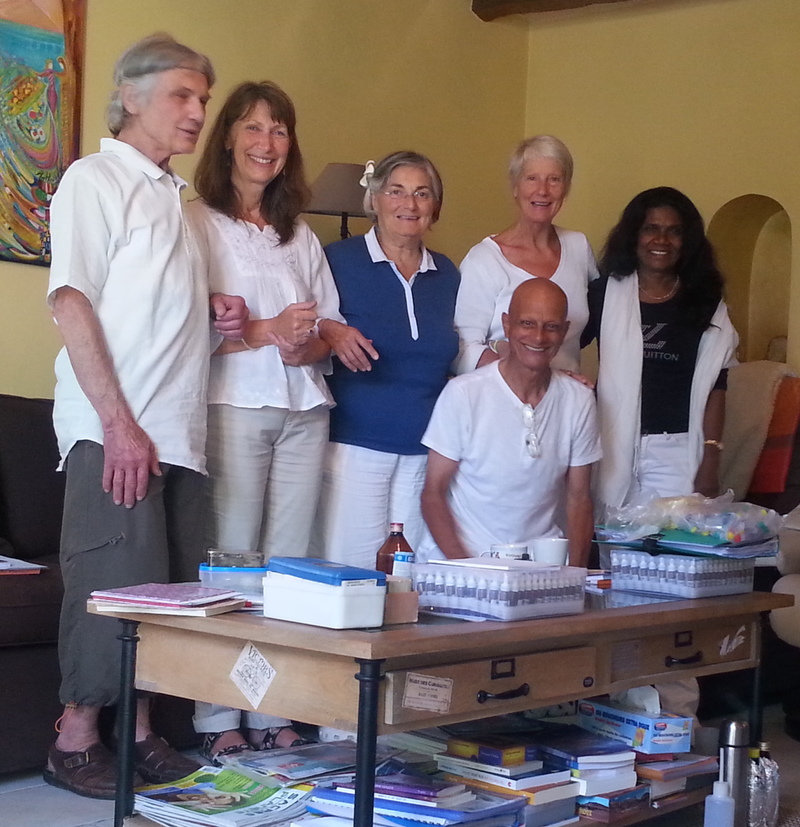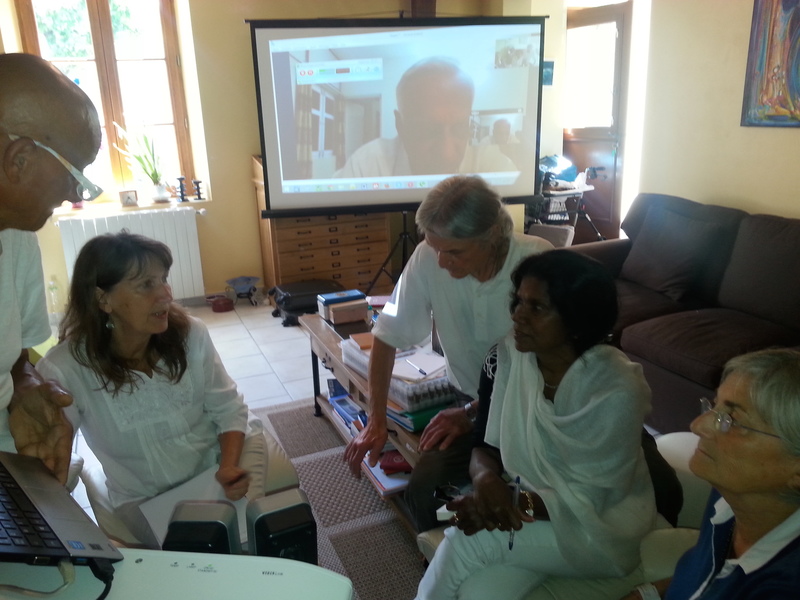In Addition
Vol 6 号 5
September/October 2015
AVP Workshop in Delhi, 4-5 April 2015
 The Delhi-NCR Coordinator02859...India reports: An Assistant Vibrionics Practitioner (AVP) training was held on 4-5 April 2015 in Delhi, India. Six participants attended after successfully completing the correspondence course. After a review of the theoretical aspects of Vibrionics, the participants were guided into its practical aspects. Model clinics were carried out in which the participants took up real cases and prescribed treatments. Dr Jit Aggarwal interacted with the students via a Skype call. In what can only be divine design, the call continued for a full two hours with no connection problems!
The Delhi-NCR Coordinator02859...India reports: An Assistant Vibrionics Practitioner (AVP) training was held on 4-5 April 2015 in Delhi, India. Six participants attended after successfully completing the correspondence course. After a review of the theoretical aspects of Vibrionics, the participants were guided into its practical aspects. Model clinics were carried out in which the participants took up real cases and prescribed treatments. Dr Jit Aggarwal interacted with the students via a Skype call. In what can only be divine design, the call continued for a full two hours with no connection problems!
Later, the new practitioners’ 108CC kits were charged. This was a very energizing experience as the chanting of Om Sri Sai Ram reverberated in the training hall. All the participants were overjoyed to receive their combo box. [Editor’s note: The AVPs who completed their training at this workshop share their experiences as new practitioners in this issue’s Practitioner Profiles.]
First AVP Workshop in France, 21-22 June 2015
The French Coordinator01620…France reports: On 21-22 June 2015, three Vibrionics students from France and Belgium, who had successfully completed their e-correspondence courses, came to Tours, France, to receive their AVP practical training. They were taught by three Vibrionics teachers, so it was almost private lesson: one practitioner per student! The applicants did well on their test and all three of them qualified as AVPs.
 For the training, we installed a very large screen to project the Vibrionics PowerPoint, so everyone could see it easily from their place and answer questions.
For the training, we installed a very large screen to project the Vibrionics PowerPoint, so everyone could see it easily from their place and answer questions.
We also assigned a special training exercise for the first night. After giving the students the 108CC book and explaining how to use it, we asked each of them to choose a case they had cited on their training application form and write it up properly, including the combos they considered giving. The next day they each read what they had written. We then discussed the treatment for each of the patients and the presentation of the case histories. This enabled the students to begin to become familiar with case histories and gain experience in researching the appropriate combos.
For the training, we prepared vegetarian meals with many vegetables and fruits for the students. We took advantage of our meals to explain and put into practice the benefits of a good diet and a healthy lifestyle.
At the end everybody was happy and blessed to have a long Skype interview with Dr Aggarwal. The new AVPs were quite enthusiastic about their session and ready to do loving seva for Swami.
Summary of the UK Practitioners’ Meeting held on 16 August 2015, Ilford, Essex
This report was compiled by UK Coordinator 02822…UK from notes prepared by Practitioner02899…UK , Practitioner 03507…UK and Practitioner03510…UK.
The convener UK Coordinator welcomed the15 practitioners in attendance including 2 participating via Skype and thanked everyone for their presence. He began by offering gratitude to Swami for blessing us with this healing science.
Excerpts follow:
1.0 Writing case histories
1.1 Guidelines for writing cases
For details, click here (You will first need to log into the Vibrionics website www.vibrionics.org, using your username and password).
1.2 Criterion for submitting cases
This has been broadened as mentioned in July/August Sai Vibrionics Newsletter. Submissions are no longer limited to extraordinary cases but may include solid ordinary ones. All practitioners should review their patient records and submit relevant cases.
2.0 Receiving patients and staying centred on Swami during consultations
Suggestions based on group discussion:
2.1 Preparing for the appointment
- Mentally cleanse and centre the mind and heart on Swami.
- Ensure that you are peaceful and are not radiating negative vibrations.
- Pray/meditate to receive divine protection from negative energies.
2.2 Putting patients at their ease
- Welcome patients warmly when they arrive for their appointment and make them feel safe and comfortable.
- A female practitioner can sit near a woman patient to help foster a feeling of closeness and trust.
2.3 Listening to patients
- Allow patients to open up and then listen patiently. Making patients feel secure enough to confide their deep-seated feelings and listening patiently are the most important aspects of treatment.
- Give quality time to your patients. Stay focused.
- When you listen compassionately, a lot of hidden things come out. This triggers the start of the healing process.
2.4 Connecting to Swami
- Maintain your inner connection to Swami while listening to the patient.
- Listen to His guidance from within.
- "Hear as Swami” when listening to the patient and allow Swami to take over the entire session
2.5 Family versus individual consultations
In family group settings, some patients may take the opportunity to disclose problems to other family members, which they were unable to talk about before. On the other hand, one-on-one consultations may also allow greater openness for patients.
3.0 Questions for discussion
3.1 Question: We recommend patients to say the Ho'oponopono phrases, “I am sorry. Please forgive me. Thank you. I love you”. Whom am I saying this to? [Editor’s note: The practitioner is referring to a Ho'oponopono (ho-o-pono-pono) mantra, used in the traditional Hawaiian practice of reconciliation and forgiveness.]
Comments:
- The phrases are said to no one in particular. They are said to the universe in general.
- The phrases are being said to the soul. Your life is the result of your actions, your lifestyle. So far you have been taking in toxins through your five senses. These statements help you cleanse yourself. By saying them, you are taking full responsibility for everything in your life. You created it all. With this, you acknowledge your mistake, you say you are sorry, and you turn your focus to love, which cleanses and heals.
3.2 Question: What do you do when the patient is uncertain of what type of headache he has?
Comment: Add both combos, CC11.3 Headaches and CC11.4 Migraines.
3.3. Discussion of a difficult case: A lady plagued by intense jealousy
A Sai devotee was intensely jealous of her sister-in-law because of her many positive qualities. Along with vibro, different approaches were suggested:
- Recite the Ho`oponopono phrases (see above)
- Practice a cleansing exercise: Close your eyes, take three deep breaths and imagine a whiteboard. Write down all your negative thoughts on the imaginary whiteboard and then wipe it clean, leaving a clean, white board, like a mind cleansed of negative thoughts (Source cited: Dr. Srikanth Sola, Golden Age Workshop)
- Develop self-love, self-knowledge, and self-confidence. The patient’s sister-in-law is only reflecting the beautiful qualities the patient herself has at soul level. Different practices can help: meditating, reading Swami’s teachings and other spiritual writings (Michael Brown’s Presence Process was cited), and using positive affirmations (those of Louise Hay were cited).
- Use Phyllis Krystal’s Heart-Ribbon technique: Close your eyes, take three deep breaths and Imagine a ribbon made of Golden Light emanating from the heart region of the picture of your favourite deity. Watch as it connects to your heart. Next, imagine the same ribbon moving from your heart to the heart of the person against whom you have any negativity/anger/resentment. Then imagine the same ribbon moving from that person's heart back to the deity's heart. This completes a triangle of the ribbon and establishes that every single living being receives equal love from the Divine and that all beings are forms of love.
3.4 Treatment of various diseases (Practitioners’ discussion)
Suggestions included:
3.4.1 For anger and fear
It is helpful to add CC4.2 Liver and Gallbladder tonic + CC4.10 Indigestion + CC13.1 Kidney & Bladder tonic.
3.4.2 For sleep disorders
- Use CC10.1 Emergencies + CC15.1 Mental & Emotional tonic + CC15.6 Sleep disorders…one dose half an hour before normal bedtime and if required, two more doses at half-hourly interval. If there is a possibility of mental issues, add CC15.2 Psychiatric disorders + CC18.1 Brain disabilities.
- SM2 Divine Protection has been used successfully on its own. Sometimes CC18.1 Brain disabilities has also been added.
3.4.3 For epilepsy
Give CC10.1 Emergencies + CC12.1 Adult tonic + CC18.1 Brain disabilities + CC18.3 Epilepsy.
3.4.4 For diabetes
- Add CC13.1 Kidney & Bladder tonic to the diabetes remedy.
- Warn patients not to stop the vibro remedy when the symptoms resolve. Instead, ask patients to discuss the reduction of allopathic medication with their doctor.
- Tell patients not to revert to eating sugary foods, biscuits and bread, as it may take a few years for the body to get back to normal. In the meantime, the patient should continue with the vibro remedy.
- Health tip for diabetics: Take one tablespoon of cinnamon powder, yoghurt and garlic in the morning and wait for 45 minutes for absorption before going about daily activities.
3.4.5 Back pain radiating down to the buttocks:
- CC20.5 Spine is the appropriate remedy.
- If you think the problem could be linked to money issues, worry and stress, add CC15.1 Mental & Emotional tonic but also add CC4.2 Liver & Gallbladder tonic + CC13.1 Kidney & Bladder tonic.
3.4.6 Psychosomatic disorders:
Give CC15.1 Mental & Emotional tonic + C15.2 Psychiatric disorders + CC17.3 Brain and Memory tonic.
3.5 Comments on the use of particular CCs:
3.5.1 CC17.2 Cleansing
- This combo can cause a pullout, so give only at the end of a treatment or near its completion, when the patient is at least about 70% better.
- It has been used at the beginning of treatment for external cleansing of the patient’s environment, with no problems.
3.5.2 CC12.1 Adult tonic
It can be good to give this initially to build strength.
